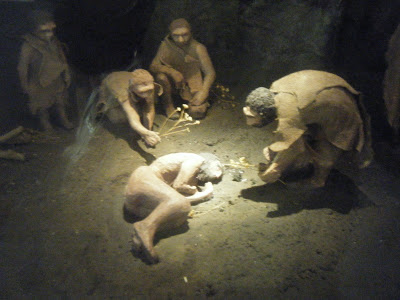The First Funeral Wreath, c. 60,000 B.C.? September 29, 2014
Author: Beach Combing | in : Prehistoric , trackbackArchaeology is an extremely vague art and the greatest danger its practitioners face is the temptation of joining chance findings together to create imaginary narratives. Take the first flower funeral in history. In 1960 Ralph Solecki, a US archaeologist, excavated a Neanderthal grave in Iraq in the famous Shanidar Cave: one of several Neanderthal graves found there and (along with Shanidar I) the most interesting. An old Neanderthal aged perhaps 35 (Neanderthals rarely lived much beyond 35) was buried c. 60000 BC. A sample of soil was taken from the grave to establish local plantlife at the time of burial. However, on being examined in a French laboratory it was found that the high pollen counts could only be explained by whole flower heads being included in the burial, heads that had survived for a long time because of the damp soil. We have what seems to be the earliest wreath in history, not predating humanity but coming from a closely-related species. Archaeologists quickly began to write delirious pages on these flowers noting that they included medicinal plants, for example, ragwort. Six out of the seven flowers identified, in fact, were said to be locally viewed as medicinal plants: but how impressive is that given that almost all flowers appear somewhere in a herbalist’s manual? Shanidar IV was very quickly christened as a shamanic healer who plied his trade in the Zagros Mountains, so we had not only the first funeral flowers but also the first doctor: there have been attempts to have Shanidar I, another burial, as the first murder victim in history so Shanidar attracts firsts. The flower doctor appeared, subsequently, as Creb in The Clan of the Cave Bear and Solecki called his monograph covering the burials: Shanidar: the First Flower People. The flowers were a nice story, and were lapped up by contemporaries. However, slowly doubts started to creep in. There were other possibilities. Perhaps flowers or pollen had blown into the grave during excavation (‘background pollen rain’)? Perhaps workers had accidentally brought pollen in? Or possibly local rodents, a gerbil of some type, had buried seeding and flowering heads above the body leading to erroneous conclusions? Were, then, the Neanderthals all but the same as us, or do we compromise their memory by anthopormothising them? The evidence is just too slight but there are constant hints at ritual from around the Neanderthal world, none of which alone amounts to a solid clue. Other thoughts on Shanidar? drbeachcombing AT yahoo DOT com



